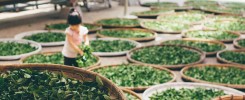As someone who has spent decades working with tea—from planting and harvesting to tasting and selling—I can confidently say that Pu-erh tea is unlike any other. For tea lovers around the world, understanding Pu-erh requires looking beyond its taste and aroma, into the science, history, and tradition that make it truly unique.
Table of Contents
1. A Living Tea That Evolves
One of the most fascinating aspects of Pu-erh is that it is a living tea. Unlike green or black tea, which are “finished” once processed, Pu-erh continues to ferment over time. There are two main types: raw (sheng) and ripe (shou). Raw Pu-erh naturally ages, sometimes for decades, slowly developing smoother flavors and richer aromas. Ripe Pu-erh undergoes a controlled fermentation process that accelerates aging while preserving its health benefits.
This living quality means that no two cakes of Pu-erh are exactly alike. Over the years, I’ve brewed the same cake multiple times, noticing subtle changes in aroma, mouthfeel, and aftertaste. For tea enthusiasts, this evolution is part of the excitement—it’s a tea that grows with you.
2. The Role of Yunnan and Ancient Trees
All authentic Pu-erh comes from Yunnan, China, often harvested from ancient tea trees that can be hundreds of years old. These trees grow in mineral-rich soil with unique microclimates, which contribute to the tea’s complex flavor profile.
I’ve visited plantations where the tea leaves are hand-picked from mountains shrouded in mist. The difference between leaves from young bushes versus ancient trees is noticeable: older trees produce leaves with deeper, more nuanced flavors and a stronger capacity to age well. For tea lovers, understanding this terroir explains why Pu-erh can taste earthy, woody, floral, or even slightly fruity depending on its origin.
3. Health Benefits You Can Notice
Many people drink Pu-erh for its reputed health benefits, and my experience confirms some of these effects. The natural fermentation produces probiotics that support gut health, making digestion smoother after meals. Pu-erh also contains compounds that can aid in fat metabolism and support cholesterol balance.
Unlike highly caffeinated drinks, Pu-erh offers a calm, steady energy. I often drink it after a heavy meal, and I notice that it lightens my stomach while keeping me alert without the jitteriness of coffee. For tea lovers who are curious about functional teas, Pu-erh provides both enjoyment and subtle wellness benefits.
4. Brewing Rituals and Mindful Drinking
What makes Pu-erh special is not just its chemistry but also the ritual of drinking it. Brewing Pu-erh properly—often in a gaiwan or clay teapot with hot water—brings out layers of flavor. Multiple infusions reveal different nuances, from earthy and woody to sweet and floral.
Personally, I find that preparing and sipping Pu-erh is a form of meditation. It encourages patience and mindfulness, letting you slow down and appreciate the process. For enthusiasts, this is part of the tea’s charm: it’s a drink that asks you to pay attention and rewards you with depth and balance.
5. Addressing Common Questions
Why is Pu-erh sometimes bitter or earthy? Young raw Pu-erh can be astringent or strong, which is normal. Aging mellows these qualities, making the tea smoother.
Does aged Pu-erh really get better over time? Yes, provided it’s stored properly—away from strong odors, in a stable, moderately humid environment. The microbial activity continues, transforming flavor and mouthfeel gradually.
How do I know if my Pu-erh is authentic? Authentic Pu-erh comes from Yunnan and is made from Camellia sinensis var. assamica. Trusted sources and recognized tea producers are the safest way to ensure authenticity.
Final Thoughts
Pu-erh tea is special because it is alive, evolving, and deeply connected to both nature and human care. It offers a rare combination: complex flavors that change over time, subtle health benefits, and a mindful, grounding drinking experience. For tea lovers, it’s not just a beverage—it’s a lifelong exploration, a way to connect with history, culture, and the natural world.
If you’re new to Pu-erh, start with a mid-aged sheng or a ripe shou Pu-erh. Brew slowly, observe its transformation over multiple infusions, and let it teach you patience. In every cup, you’ll discover why Pu-erh has been treasured for centuries.

